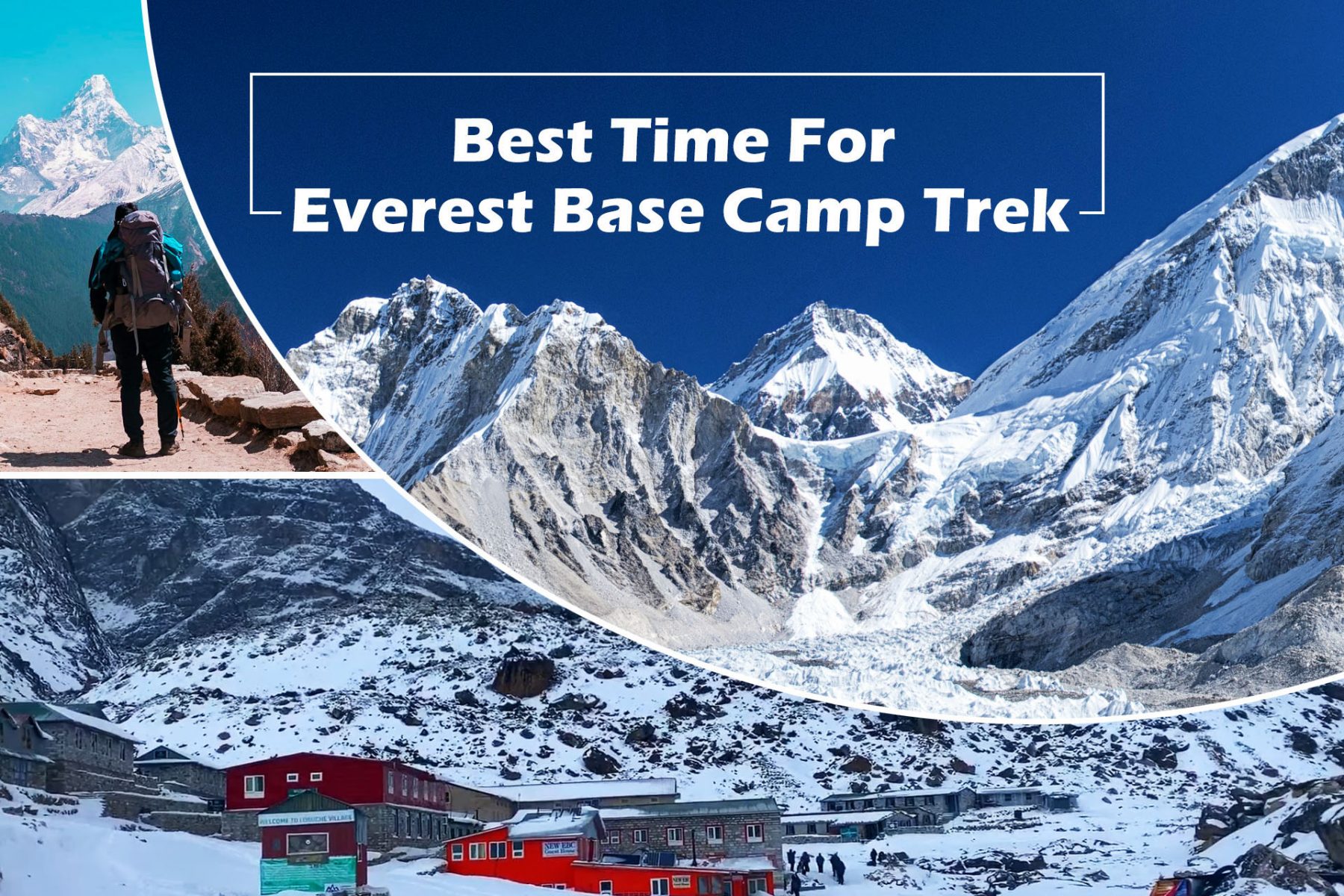How difficult is Everest base camp trek

How difficult is the Everest Base Camp Trek?
How difficult is the trek to Everest Base Camp? Are you looking for an answer to this question? If so, your search ends here. From this blog, you can know in detail how difficult the trek to Everest base camp is. If you are trekking Everest Base Camp for the first time, you must know the difficulty level.
The name sounds scary, but the Everest base camp trek is relatively easy. Each year, around 30,000 people trek to Everest Base Camp to catch a glimpse of the world’s tallest mountain. People of all age groups have completed this trek. Almost anyone can conquer the trek with a little preparation and determination. The Everest base camp trek requires no technical expertise or mountaineering skills. It’s a long hike uphill. Anyone with basic fitness can achieve it, but some considerations remain.
The trek to Everest Base Camp is tough, but it is an achievable goal for many people. You don’t need to be an athlete or a high-altitude climber. However, it is necessary to prepare yourself by understanding the difficulties that may occur during trekking.
Trekking to Everest Base Camp is not a luxury trip, even if you stay overnight in luxury lodges along the trail. This trek is a test of your endurance and patience. You create new boundaries by pushing your limits. It means that trekking to Everest base camp is not even the most difficult trek in Nepal. Even if you are a beginner trekker, a balance of knowledge and preparation will help you easily complete this trek.
Trekking to Everest Base Camp is an adventure of a lifetime for anyone. It can be a life-changing experience for many people. So, it is important to understand its terrain and elevations and prepare accordingly. Many people who start the trek do not finish it because they need more preparation. Because of this, they pay for the helicopter to return to Lukla or Kathmandu.
It is a trek to the base of Everest, not the summit. So, is the Everest base camp trek easy? Yes, it’s easier than climbing a peak. However, it would be wrong to underestimate the difficulty of the Everest Base Camp trek. This trek can be brutal if you are unprepared and need help understanding its challenges.
Various factors make the trek difficult. It is important to know the factors that make the trek difficult. If you are aware of these factors, it helps to reduce the unexpected risks that may occur during trekking. So, let’s look at the factors that make the Everest Base Camp trek difficult.
Altitude sickness during Everest Base Camp Trek
One thing that makes the Everest Base Camp trek difficult is the high altitude. Altitude sickness is common during high-altitude trekking. High-altitude Sickness is also known as acute mountain sickness (AMS). It happens when you reach a high altitude quickly, usually above 2,500 meters (8,000 feet). The effects of altitude on your body are only felt once you hike 2,500 meters above sea level. But, above 2,500 meters, the symptoms of altitude sickness begin to appear. Altitude sickness is caused by low oxygen levels and reduced air pressure at high altitudes.
Some common symptoms of high-altitude sickness include headaches, nausea, fatigue, dizziness, and shortness of breath. Knowing about altitude sickness while trekking to Everest base camp is important. If you underestimate it, it can cause serious problems. Altitude sickness is common during high-mountain trekking, but you can avoid it by taking precautions. You need to follow some guidelines to reduce the risk of altitude sickness.
Gradual ascent: Ascend slowly, allowing your body time to adjust to changes in oxygen levels. Gain under 500 meters daily when you are above 3,000 meters.
Adequate hydration: Drink plenty of water and other fluids to stay hydrated. Avoid consuming alcohol and caffeine; it can cause dehydration.
Proper nutrition: The body needs nutrients to cope with changes in height. Make sure your diet is balanced with essential nutrients. Include whole grains, lean proteins, fruits, vegetables, nuts, and seeds in your diet.
Acclimatization days: Plan rest days during your climb. Rest days allow your body to adjust to the higher altitude. Consider spending an extra day at certain altitudes before reaching higher altitudes.
Medication: Sometimes, you can use acetazolamide (Diamox) to help prevent altitude sickness. But take it according to the doctor’s advice and instructions.
Recognize the symptoms: Be aware of the symptoms of altitude sickness. If you experience symptoms of altitude sickness, take appropriate action immediately. It is a good idea to descend to a lower altitude if severe symptoms occur.
Take regular breaks: Take regular breaks to allow the body to adjust during the ascent.
Aware of Khumbu cough
Khumbu cough is also a factor that can make the Everest Base Camp trek difficult. “Khumbu cough” is a term used to describe a persistent dry cough. You may experience this cough when you reach higher altitudes in the Khumbu region. This cough occurs due to various reasons related to the high-altitude environment.
Cold and dry air: At higher altitudes, the air is drier and colder, which can lead to a dry, persistent cough.
Dust particles: Trekking trails in the Khumbu region can be dusty, especially during the trekking season. During the trekking season, trekkers and yaks move a lot. Dust and particles can cause coughing.
Physical Activity: The trek to Everest Base Camp involves strenuous physical exertion at high altitudes. Excessive inhalation of thin air can irritate the respiratory system and cause coughing.
It is important to avoid Khumbu cough while trekking. To reduce the effects of cough, here are some tips:
Stay Hydrated: Drink plenty of water and other fluids to keep the respiratory tract hydrated. It helps reduce irritation caused by dry air and dust.
Cover your mouth and nose: Cover your mouth and nose well with a buff, scarf, or mask. It can help filter the air you breathe, reducing the inhalation of dust and particles.
Rest: Take breaks to allow your body to acclimate to the high altitude. Before attempting higher altitudes, spend some acclimatization days at certain altitudes. It can help reduce stress on the respiratory system.
Cough drops: Carry cough drops or lozenges. It can help soothe a dry or irritated throat and relieve a cough.
Appropriate clothing: Dress in layers to protect against cold temperatures. Cover your mouth and nose in windy or dusty conditions.
Medical advice: Sometimes, the cough may persist or become severe, especially with other symptoms of altitude sickness. In that case, seeking medical advice from a healthcare professional or trekking guide is necessary.
Terrain Condition of Everest Base Camp TREK
The route to Everest Base Camp (EBC) offers panoramic views of the world’s highest peak. This route takes hikers through different landscapes and different terrains. However, Everest Base Camp presents various challenging terrains that can make trekking hard. The terrain can be challenging, with steep ascents and descents, rocky terrain, uneven trails, and muddy sections. Trekkers typically encounter different types of terrain, including:
Height: One of the most important challenges during trekking is the high altitude. At higher altitudes, the air becomes thinner, resulting in less oxygen. It can lead to altitude sickness, which makes trekking more physically demanding and challenging.
Step ascents and descents: The routes to Everest Base Camp involve steep ascents and descents. Walking such trails can be physically demanding, especially for those not accustomed to hiking.
Unpredictably changing weather conditions: The weather in the Everest region can be unpredictable. Sudden weather changes can affect trail conditions and make trekking more challenging.
Rocky Paths: These paths often have rocks and stones, making the trek more demanding and difficult.
Moraine: Glacier debris forms moraines. It is a pile of rocks and sediments. They can create uneven surfaces and make navigation difficult.
Glaciers: Some glacier sections need crossing, which involves walking on ice. Be careful when walking on crevasses and icy surfaces. Sometimes, it also demands the use of special equipment.
Ice Formations: In certain areas, you may encounter ice formations such as ice walls, especially at high altitudes.
Narrow Trails: Some trek parts include narrow trails with steep drop-offs. Such narrow trails add difficulty and require concentration while hiking.
The Everest Base Camp trek has several challenging sections and trails. Some of the more challenging trails and sections of Everest Base Camp are:
Namche Bazar to Tengboche: This section involves a steep incline from Namche Bazar to Tengboche. It is a relatively short distance, but it gains considerable altitude. From a height of 3,440 meters, you reach a height of 3,860 meters. The trail can be physically demanding due to its steep incline.
Tengboche to Dingboche: The trail from Tengboche to Dingboche involves climbing through rugged terrain. The altitude increases significantly, and the thin air can make breathing difficult.
Lobuche to Gorak Shep: The trek from Lobuche to Gorak Shep includes rocky moraines and the Khumbu Glacier. This section can be physically challenging due to the uneven and rocky terrain.
Gorak Shep to Everest Base Camp: The final push from Gorak Shep to Everest Base Camp involves a rocky and icy walk. The trail can be tough due to elevation, rocky surfaces, and possible ice.
Ascend Kalapatthar: Kalapatthar is not a part of the EBC trekking trail. But many trekkers ascend Kalapatthar to witness the stunning sunrise. Kalapatthar is the highest point of the EBC trek, with a height of 5,545 meters. Ascending from Gorak Shep to Kalapatthar can be physically demanding due to the high altitude and steep inclines.
Despite these difficulties, thousands of trekkers complete the EBC trek each year. Coping with these challenging sections requires physical stamina, proper acclimatization, and mental determination. Terrain may vary depending on the specific route you take and weather conditions. It is essential to be adequately prepared to navigate the varied terrain of the trek safely. Being physically fit and equipped with the appropriate gear is also important.
You may like: Everest Gokyo Lake Trek 12 Days, itinerary, weather, difficulty
Pick the right itinerary
Choosing a proper itinerary is essential to facing the hardships of Everest Base Camp trekking. Your itinerary should include altitude, daily walking hours, walking distance, and acclimatization days. Consider whether the itinerary’s altitude, walking hours, and distance match your physical ability.
How far is Everest Base Camp? Distance refers to the total distance covered during a few days of trekking. The Everest Base Camp Trekking Trail covers a total of 130km. Covering this distance may be difficult for those not used to trekking in the mountains. Be prepared to hike up the hill for hours, carrying your light backpack. Don’t worry; it is possible, even without a trekking experience.
Experienced trekkers with excellent strength and endurance can complete this in 12 days. But for inexperienced and first-time trekkers, it is a good idea to opt for a 16-day itinerary. A 16-day itinerary includes less daily walking distance and more rest days. But if you choose a less than 12-day itinerary, it can make it difficult for you. Generally, the 14-day Everest base camp trekking itinerary is best for everyone.
Everest Base Camp Trek: 14 Days
- DAY 01: FLY KATHMANDU TO LUKLA (2,840 M) AND START TREK TO PHAKDING (2,610 M)—4 TO 5 HOURS WALK.
- DAY 02: PHAKDING TO NAMCHE BAZAAR (3,440 M): 6 TO 7 HOURS WALK.
- DAY 03: FREE DAY AT NAMCHE BAZAAR.
- DAY 04: NAMCHE BAZAAR TO TYANGBOCHE (3,860 M): 5 TO 6 HOURS WALK.
- DAY 05: TYANGBOCHE TO DINGBOCHE (4,410 M): 5 TO 6 HOURS WALK.
- DAY 06: REST DAY AT DINGBOCHE.
- DAY 07: DINGBOCHE TO LOBUCHE (4,910 M): 5 TO 6 HOURS WALK.
- DAY 08: LOBUCHE TO EVEREST BASE CAMP (5,364 M) AND BACK TO GORAKSHEP (5,140 M)—8 TO 9 HOURS WALK.
- DAY 09: GORAKSHEP TO KALAPATTHAR (5,545 M) AND DOWN BACK TO PHERICHE (4,240 M) – 7 TO 8 HOURS WALK.
- DAY 10: PHERICHE TO PHORTSE (3,810 M): 5 TO 6 HOURS WALK.
- DAY 11: PHORTSE TO NAMCHE (3,440 M): 5 TO 6 HOURS WALK.
- DAY 12: NAMCHE TO PHAKDING (2,610 M): 4 TO 5 HOURS WALK.
- DAY 13: PHAKDING TO LUKLA (2,840 M): 4 TO 5 HOURS WALK.
- DAY 14: FLY LUKLA TO KATHMANDU—45 MINUTES.
It is a suitable itinerary for most trekkers. Please let us know if you need a different itinerary. We will help you prepare an excellent travel plan according to your abilities and desires.
Weather and climate
Another factor that can make an Everest trek difficult is weather and climate. The difficulty level can be higher if the weather is not good during your trek. Therefore, it is necessary to understand the weather pattern of the Everest region well and be careful about it.
The weather in the Everest region is unpredictable and can change quickly. Sudden rain, strong wind, or snow may occur even during the trekking season. Prepare yourself in advance for unpredictable and rapidly changing weather. The weather in the Everest region is only sometimes favorable for trekking. So, knowing what time is best for Everest base camp trekking is important.
There are four seasons in Nepal: summer, winter, spring, and autumn. The summer season includes June, July, and August. Heavy rainfall at lower elevations during the summer makes the trail wet and slippery. Rain can cause landslides, and trail closures can make your journey difficult. Dust and fog after rain can obscure trail vision and increase risk. Flights can also be high-risk due to low visibility. Even breathing feels difficult at high altitudes. As summer is a closed season for trekking, it is better not to plan a trek during this time.
Another season is winter, which includes November, January, and February. It is extremely cold during this season. It makes your Everest trek difficult. January is the coldest month of the year. This month, the Everest region’s temperature drops by 20 to 30 degrees. Despite the low temperatures, trekkers’ biggest problems are storms, strong winds, and wind chill.
The sky is generally clear this time, but trekking above 4,000 is difficult. So, this season is also not a good time to trek to Everest Base Camp. However, some trekkers prefer to trek on quiet trails and snow-capped mountains. Such trekkers must take more pre-planning and precautions to face the cold weather.
Winter and summer are off-seasons for trekking in Nepal. Off-season has the worst weather conditions, which makes the trek very difficult. You can’t predict anything. Lukla flights are often delayed or even cancelled due to bad weather. Therefore, very few trekkers trek to Everest base camp during the winter and summer.
Another season is spring, which includes the months of March, April, and May. During this season, the Everest region’s weather conditions are relatively stable and favorable. Temperatures are mild, and days offer stunning mountain views with clear skies. Rhododendrons, magnolias, and other colorful flowers bloom along the trails. The vibrant and picturesque landscape adds to the trek’s beauty. There is less chance of encountering heavy rain or snowfall, which makes trekking conditions safer. During this time, the snow starts to melt, making navigating and crossing some high passes easier. Spring is a good time to trek to Everest Base Camp because of the favorable weather. But note that the trails and accommodations can be busier than at other times of the year.
Another season is autumn, which includes the months of September, October, and November. Autumn is the most popular and best trekking season for the Everest base camp trek. During this season, the climate is cool, and the scenery is breathtaking. Autumn offers stable and clear weather conditions in the Everest region, making your journey easy. Since the monsoon season is over, the rain chances are less, and the sky is clear. So, choose spring (March, April, May) or autumn (September, October, November) to plan your trip.
Preparation and Training
The difficulty of the Everest base camp trek also depends on preparation and training. Yes, one main reason the Everest Base Camp trek is difficult is the lack of adequate training. Reaching Everest Base Camp without any training is possible, but we do not recommend it at all!
Your endurance and strength levels may differ from others. You should be physically fit and energetic for the trek. Walking on unpaved, rocky roads and adjusting to hilly terrain is difficult for frail people. So it is important to start doing the necessary exercises to strengthen the leg muscles.
This trek does not demand superhuman fitness, but good physical preparation is essential. You need to be able to walk 5-7 hours a day on different terrains with backpacks. You don’t need to hire a personal trainer; regular exercise and fitness training are enough. Here are some recommendations for exercise and preparation:
Cardiovascular Exercise: Do activities that improve cardiovascular endurance, such as hiking, running, cycling, or swimming. Focus on at least 30–60 minutes of aerobic exercise 3–4 days a week to build stamina.
Strength Training: Do strength exercises to build muscle endurance, especially in the legs, core, and upper body. Exercises like lunges, squats, planks, and push-ups are beneficial.
Mountaineering and trekking exercises: Practice uphill climbs and trekking on uneven terrain 1 month in advance. Gradually increase the duration and difficulty of your hike to tackle the Everest Base Camp trek.
Flexibility and stretching: Include stretching exercises and yoga. It helps improve flexibility and prevent injuries during the trek.
Pack Training: Familiarize yourself with carrying a backpack during the trek. Start with light weights and gradually increase the load. You can hire a porter to carry luggage, although you must carry some light items for personal use.
Hydration and Nutrition: Include carbohydrates, proteins, and healthy fats. Drink plenty of water before, during, and after exercise to stay hydrated.
Rest and Recovery: Take rest between workouts to allow the body to recover and adapt to training.
Medical check-up: Consult a doctor before embarking on the trek to ensure you are fit for high-altitude trekking. They may recommend specific medications or precautions for altitude sickness and other illnesses. Don’t forget to take basic medicine or first aid with you.
Remember that mental preparation is also important. Trekking to the Everest base camp is physically as well as mentally demanding. Training prepares not only the body but also the mind for the challenges of trekking. So, be mentally prepared and understand your challenges during the trek. Mental resilience and determination play an important role in completing a high-altitude trek.
Packing the right gear and clothes
Packing the right gear is important to your Everest Base Camp trek’s safety. Not packing the right gear and clothes can lead to difficulties during trekking. The weather in the Everest region can be extremely harsh and unpredictable. Appropriate gear ensures you are prepared for the hazardous conditions that may arise while trekking.
The gear and clothing you use should be appropriate and comfortable. Comfortable clothes and gear make trekking easier and allow more enjoyment. Finding specific gear or clothing options on a trek can take time and effort. So, the right packing ensures you get what you need. Make a packing list of high-quality essentials to ensure safety, considering the weather and altitude. Bring the necessary equipment, or you can buy or rent it in Kathmandu. Here is a list of essential items to consider for the Everest Base Camp Trek:
Clothing:
- Lightweight and quick-dry, comfortable trekking pants
- Long-sleeved, moisture-wicking, breathable shirts
- Fleece or a down jacket for warmth
- Waterproof and windproof jacket
- Thermal underwear or base layers
- Trekking socks (wool or synthetic blend)
- Gaiters (optional, for certain treks with snow or dust)
- Sun hat, beanie, scarf for neck protection, warm hat
- Gloves (lightweight and warm for lower altitudes, insulated for higher altitudes)
- Bandanas or buffs for dust and sun protection
Equipment:
- Durable backpack (40–60 liters) with rain cover
- Waterproof hiking boots with ankle support
- Lightweight and comfortable shoes and sandals for teahouses or camps
- Sleeping bags suitable for colder temperatures
- Sleeping pad or mat for insulation and comfort
- Trekking poles for stability and support
- Headlamp with extra batteries
- Water bottles or hydration bladders (2-liter capacity recommended)
- A waterproof duffel bag for porters to carry your gear
- UV protection sunglasses
- Personal locator beacon or satellite phone (if trekking in remote areas)
- Portable solar charger or power bank for electronic devices
Personal Items:
- Personal identification documents (passport, visa, permit, emergency contact information)
- Trekking map or guidebook for route guidance
- Travel insurance information
- Cash (Nepalese rupees), credit or debit cards
- Basic toiletries (toilet paper, toothbrush, toothpaste, biodegradable soap, hand sanitizer, wet wipes)
- Sunscreen (SPF 30+), lip balm, and moisturizer to protect against UV rays
- Personal medication and a basic first-aid kit
- Trekking towel
Miscellaneous:
- Water filters or purification tablets
- Lightweight and quick-drying travel towel
- Lightweight and compact trekking clothes for teahouses
- Flip-flops or camp shoes for evenings
- Camera or smartphone for capturing memories
- Travel adapter (Nepal uses type C, D, and M plugs)
- Ziplock bags (useful for waterproofing and organizing)
- High-energy snacks and bars for quick boosts during the trek
- Trekking permits and necessary paperwork (arranged in advance)
- It is a good idea to consult your trekking agency for other specific gear recommendations.
Acclimatization
Everest Base Camp is a high-altitude trekking camp above 5000 meters. The risk of altitude sickness is common when trekking at high altitudes. At altitudes above 2500, the oxygen level decreases, which causes altitude sickness. Above 3,500 meters, oxygen levels are lower, so the body needs more time to adjust. Achieving an altitude of over 5,000 meters requires serious concentration. Acclimatization helps the body adjust to the thin air at high altitudes.
During a hike, it is important to allow the body to adjust to reduced oxygen levels. Staying an extra day at certain altitudes is the most effective way to reduce the risk of altitude sickness. So, it is essential to include acclimatization days in the itinerary for a safe Everest base camp trek. Trekking to Everest base camp is tough if you walk continuously at altitude without acclimatization days. Remember that it is best to ascend slowly to allow the body to adjust to the change in altitude.
If you are well acclimatized to low altitudes, then the trek becomes easy at high altitudes. But if you are well acclimatized to low altitude, then trekking at altitude will be easy and safe. The more time you spend at certain important points, the easier it is to complete the trek. Choose an itinerary with scheduled rest days to acclimatize to certain altitudes. Acclimatization at Namche and Dingboche is essential for the Everest Base Camp trek.
If you have high-altitude trekking experience, there is no need to acclimatize for the Everest Base Camp trek. But for a novice trekker, we suggest a proper itinerary with acclimatization days. Most itineraries include two nights in Namche. Namche is a popular Sherpa town and a rest stop for many trekkers. Namche Bazaar is at an altitude of 3,440 meters (11,286 feet), making it an ideal location for acclimatization. Spending an extra day here is important to allow the body to adjust to the high altitude before climbing.
While staying at Namche Bazar, you can go for custom hikes at nearby landmarks. A hike to the Everest View Hotel near Namche Bazaar is the best option. Acclimatization Day in Namche is also an opportunity to explore the market and village. The top 10 things you can do in Namche:
- Visit the Sherpa Culture Museum.
- Visit Sangboche Airport.
- Explore the local market.
- Visit the Sagarmatha National Park Visitor Center.
- Hike to Khumjung or Khunde village.
- visit monasteries
- Visit the Sherpa settlement.
- Enjoy the local cuisine.
- Visit the world’s highest Irish pub.
- Embark on a short hike to the Everest View Hotel.
Reliable trekking agency and trained guide
Trekking with a reliable trekking agency is essential for safe and comfortable trekking. If you choose the wrong trekking agency, you may face many difficulties during trekking. We recommend choosing a local trekking agency for a safer and better experience. They are based in Nepal and have extensive knowledge of the region, culture, and terrain. This specialization can provide a more authentic and immersive experience. Some reasons to choose a reliable trekking company are:
Expertise and Experience: Reliable and experienced companies have had good knowledge of trekking operations for a long time. They have experienced guides and staff familiar with the terrain and trails. Their expertise helps minimize risks and enhance your overall experience.
Safety: These companies understand the potential risks well and focus on security protocols. They have experienced guides, proper equipment, and emergency evacuation plans.
Permits and Documents: You need permits to trek in the Everest region. A reliable agency will assist you in issuing the required permits. They also provide you with information if there are any other legal aspects related to permits and documents for trekking.
Accommodation and Food Arrangement: Good arrangements for accommodation, food, transportation, and other logistics are essential during trekking. There is no need to worry about where to stay or eat while trekking with a reliable company. A reliable agency can make good arrangements for accommodation or meals during the trip.
Peace of Mind: Being with a trusted agency allows you to focus on enjoying the trek without unnecessary worries. It provides peace of mind and increases the chances of a positive trekking experience.
Follow the steps mentioned below to choose a reliable trekking company in Nepal.
- Check the legal documents for company registration.
- Read company reviews (TripAdvisor and Google reviews) and testimonials thoroughly.
- Check out the profiles of the Board of Directors and get information about their experience.
- Check how long the company has been operating. Generally, companies that have been operating for a long time are experienced and reliable.
- Find the company’s landline phone number and business address, and check if they are correct.
- Email some trekking agencies for inquiries.
- Two-way communication also helps in understanding how reliable the company is.
Having an experienced licensed guide and a reliable trekking agency is also important. Hiring experienced local guides and porters will ensure a safe and enjoyable trip. Earlier, you could do a solo trek, but after 2022, it is restricted. So, hiring a licensed trekking guide for the Everest Base Camp Trek is a must. From the point of view of safety, it is also better to have a guide along with you during the trekking.
The trekking company you choose can provide local and trained trekking guides. Trekking involves challenging terrain, and you may face unpredictable weather. Guides are trained in emergency procedures and can take appropriate measures to ensure safety. They are familiar with the trekking area and can provide good information about the local culture and customs. They also play an important role in arranging accommodation and food and navigating the trails.
Porters also play an important role in making the Everest Base Camp trek safe, easy, and enjoyable. Hiring a porter is a good idea to carry the heavy gear and equipment required for the trek. It lightens your load and lets you focus on the trek instead of carrying a heavy backpack. By having a lightweight backpack, you experience less physical stress and fatigue.
Food and Accommodation
While trekking to Everest base camp, accommodation, and food can make your journey difficult. But due to the growing popularity of this trek, it has improved significantly nowadays. However, there are still some difficulties you may face.
Some food items may be less available due to transportation challenges at higher altitudes. Most teahouses offer a menu with basic foods like Dal Bhat (rice and lentils), noodles, soups, and local. Fresh produce availability may be less likely, especially at higher elevations. Although at a lower altitude, you can find many options for Nepali local food as well as continental dishes.
Altitude can affect appetite and reduce the desire to eat. Consuming enough calories is essential to maintaining energy levels. Bring snacks and energy bars for supplemental meals. Finding a source of clean water can be challenging. Although bottled water is available in some teahouses, it is not eco-friendly. Bottled water on the trekking trail may not always be easily accessible or affordable. Carry a water purification system or tablets to ensure access to safe drinking water.
If you trek to Everest Base Camp, you’ll likely stay at teahouses. Most of the locals run teahouses in various villages along the trekking route. A teahouse is like a small lodge with simple rooms with beds, pillows, mattresses, and blankets. All those teahouses provide basic bedding and food but expect little else. So, at high altitudes, you should appreciate what they offer.
You can get cold water for free, but it is difficult to take a bath at high altitudes due to the extreme cold. So, in many places, you have to pay extra for hot water for bathing. A hot shower costs about $5 per person. Toilets are available almost everywhere along the route. But toilets in teahouses and basic trekking lodges are simple, i.e., squat toilets. At lower altitudes, there are western commodes, but above 4000m, there are squat toilets. Shared toilets and bathrooms are common, and hygiene can be challenging in some remote locations.
There is a high demand for rooms during the peak trekking seasons (spring and autumn). Arriving late in the day may result in limited options or the non-availability of rooms. So booking a room in advance while trekking in the main season is better. It is important to be mentally prepared for basic amenities and local food to make your trek successful. Moreover, a reputable agency and an experienced guide can help reduce these difficulties more effectively.
Conclusion
The Everest Base Camp Trek is a moderately challenging possible trek. But a novice or experienced trekker with good physical fitness can opt for this trek. Although you should consider the above factors that can make the Everest Base Camp trek difficult. If you can plan and manage these elements in advance, you can complete your trek successfully. We hope you got the answer to your question about how difficult the Everest Base Camp Trek is. If you still have any questions about Everest Base Camp’s difficulty level, please ask us.
Some frequently asked questions about the Everest Base Camp Trek
What is the best time to trek Everest Base Camp?
The best time to trek to Everest Base Camp depends on your preference and experience. Generally, there are two primary hiking seasons: The spring season (March to May) is a good time to trek to Everest base camp. The weather during this season is relatively stable, with clear skies and warm temperatures.
The autumn (September to November) season is another good time for trekking. Even during this season, the weather is clear and offers excellent visibility of the mountains. Temperatures are moderate, and skies are generally clear. Note that these are the popular trekking seasons, so the trails and lodges are crowded.
Is it important to get travel insurance for the Everest base camp trek?
Taking travel insurance while trekking is not mandatory, but it is better to take it. Remote areas may face various risks and challenges, especially at high altitudes. Travel insurance is essential to reduce the risk in such bad situations. The cost is very high at high altitudes if you need to evacuate by helicopter in an emergency. Travel insurance with adequate coverage can help you reduce these expenses.
Your trip may be cancelled due to flight cancellations, personal emergencies, or natural disasters. Similarly, you may incur expenses for medical treatment, hospital stays, and medicine if you get sick. Travel insurance can cover these expenses. So, ensure your insurance policy covers helicopter evacuation and other potential risks associated with travel.
Can beginners trek Everest Base Camp?
Everest Base Camp, being a high-altitude trek, is physically demanding. It is challenging even for experienced hikers. However, the trek is possible for beginners with good fitness and adequate preparation. Beginners should focus on improving their physical fitness before attempting trekking. Gradual ascent, rest days, and staying hydrated are essential to prevent altitude sickness. For beginners, going on a trek with experienced guides is highly recommended.
How long does it take to complete the Everest base camp trek?
The duration of the Everest base camp trek depends on the route and individual fitness level. If your physical fitness is good and you can walk uphill at a good pace, you can complete it in 12 days. But if you can only walk for a short time at a high altitude and need to rest, it may take up to 18 days. On average, most trekkers choose a 14-day Everest base camp trip itinerary. A 14-day itinerary is suitable for almost everyone.
What is the height of the Everest base camp?
The height of Everest Base Camp is about 5,364 meters (17,598 feet) above sea level. The base camp is also the starting point for climbing Mount Everest, the world’s highest peak. But remember that the maximum height of the Everest Base Camp trek is 5545 meters. If you trek, you also hike up to Kalapatthar for sunrise, which is at a height of 5545 meters.
Are permits required for the Everest Base Camp trek?
Yes, you need permits for the Everest Base Camp Trek. The Everest National Park entry permit and the Pasang Lhamu Municipality entry permit are required. A TIMS (Trekkers Information Management System) card was once required but is no longer applicable. You can get these permits at the Everest National Park entrance checkpoint.
What is the level of difficulty for the Everest Base Camp trek?
The Everest Base Camp trek is moderately difficult. Due to the duration, elevation, and varying terrain, this is a challenging trek requiring good fitness and stamina. Despite these challenges, many trekkers complete this trek with adequate preparation and determination. Before attempting the trek, we recommend physical training, including cardio and hiking exercises.
How should I prepare for the Everest Base Camp trek?
Preparation for the trek involves physical training, logistical planning, and mental preparation. Focus on building endurance and strength. Do cardiovascular exercises like hiking, jogging, cycling, and swimming. Strengthen leg muscles by doing squats, lunges, and calf raises. Consider altitude training to acclimate your body to altitude. Invest in quality trekking gear and pack accordingly.
Consult a healthcare professional for medication and health precautions for altitude sickness. Choose an itinerary with gradual ascents and enough acclimatization days to avoid altitude sickness. Book your trek with a reputable trekking agency to ensure safety and support.
Is altitude sickness a serious concern during the Everest Base Camp trek?
Altitude sickness is a major concern during the Everest base camp trek. Altitude sickness occurs when the body cannot adapt properly to high altitudes with low oxygen levels. Its symptoms can range from mild to severe. Its symptoms include headaches, nausea, dizziness, fatigue, loss of appetite, and difficulty sleeping.
Severe cases are potentially life-threatening conditions and require immediate medical attention. Altitude sickness can affect anyone, regardless of age or fitness level, so it should not be ignored. Awareness of the symptoms and following your guide’s advice can significantly reduce the risk of altitude sickness. Ascend gradually and stay hydrated to reduce the risk of altitude sickness.
What are the arrangements for food and lodging during the trek?
Various food and accommodation options are available along the Everest Base Camp trek route. The most common form of accommodation on the trekking route is teahouses or lodges. Teahouses are like basic guesthouses, with rooms with basic amenities like beds, blankets, and shared bathrooms.
You can get food as well as accommodations in teahouses. Various dishes are generally available, such as those from Nepali, Tibetan, Indian, and international cuisines. Many teahouses offer dal bhat (rice and lentils), noodles, soups, momos (dumplings), pasta, etc. Sometimes, there are also pizzas or burgers.
Expect fewer options at higher altitudes due to limited supply and transportation difficulties. Trekking to Everest Base Camp requires being flexible with accommodation and food choices. It’s a good idea to carry some extra snacks or energy bars.
Is there any age restriction for the Everest base camp trek?
There is no official age restriction for the Everest Base Camp trek. However, because it is a challenging trek, it may not be suitable for children or elderly people. Older people and children may be more susceptible to altitude-related problems. Yes, there is no age restriction, but trekkers must consider physical fitness and the challenges of the trek.
Do I need a guide for the Everest Base Camp trek?
Yes, you need a guide for the Everest base camp trek. According to the rules, a guide is mandatory for trekking in Nepal. So, Everest base camp trekking is prohibited in Nepal without a guide. From a safety point of view, high-altitude trekking also requires an experienced guide.
Is it safe to trek to Everest Base Camp?
Trekking to Everest base camp is generally safe for those who prepare well and follow safety guidelines. However, the inherent risks associated with high altitudes need to be considered. There are risks associated with altitude sickness, weather conditions, physical demands, trail conditions, etc. Despite these risks, thousands of trekkers complete the trek successfully with proper planning and safety precautions. Hiring an experienced guide and following safety guidelines can make your trek safe and enjoyable.
Can I trek Everest Base Camp independently, or is it better to join a group?
According to the rules, you cannot trek independently in Nepal. Any trek without a guide is prohibited. So, hiring a licensed trekking guide for the Everest Base Camp Trek is a must. You can do an individual or group trek if you hire a guide. It is a good idea to join a group for the Everest Base Camp trek. In case of an emergency, you can get good support from group members. Groups usually have experienced guides who provide overall security. Joining a group shares expenses, which also reduces costs.
Is there a helicopter rescue available in case of emergency?
Yes, helicopter services are available for emergency rescue. However, helicopter rescues are subject to weather conditions, availability, and other logistical factors. Flights may be delayed or cancelled due to inclement weather, poor visibility, or unsafe flying conditions. Guides or trekking agencies can arrange for helicopters if an emergency arises during the trek. Remember that it is important to have travel insurance that covers emergency medical evacuation.
You May Like: Namche Bazaar, a gateway to the Himalayas







